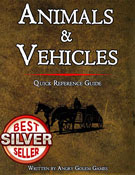Medium beast (animal), unaligned
Armor Class 11 (Natural Armor)
Hit Points 19 (3d8+6)
Speed 40 ft., climb 30 ft.
Proficiency Bonus +2
Proficiency Bonus +2 (5th Edition Advanced Mode)
| STR | DEX | CON | INT | WIS | CHA |
|---|---|---|---|---|---|
| 15 (+2) | 10 (+0) | 14 (+2) | 2 (-4) | 12 (+1) | 7 (-2) |
Skills (suggested) Perception +3
Senses passive Perception 13
Challenge 1/2 (100 XP)
Bear Hug (suggested). If both claws hit the black bear can also hug the target as a bonus action and inflicts 9 (2d4+4) bludgeoning damage. No hit roll required.
Keen Smell. The bear has advantage on Wisdom (Perception) checks that rely on smell.
ACTIONS
- Multiattack. The black bear makes two attacks, one with its bite and one with its claws.
- Multiattack (suggested). The black bear makes three attacks, one with its bite and two with its claws.
- Bite. Melee Weapon Attack: +3 to hit, reach 5 ft., one target. Hit: 5 (1d6 + 2) piercing damage.
- Claws. Melee Weapon Attack: +3 to hit, reach 5 ft., one target. Hit: 7 (2d4 + 2) slashing damage.
- Claw (suggested). Melee Weapon Attack: +3 to hit, reach 5 ft., one target. Hit: 4 (1d4 + 2) slashing damage.
5th Edition Advanced Mode
Limiting the power of a character and making the overall difficulty of the game harder, does not reduce the creativity, indeed it does quite the opposite. The Game Master has the option to use any and all of the instances proposed in this guide, or just some of them according to their preference.
DESCRIPTION
The black bear is a medium-sized beast that resembles a real-world black bear. It has thick, dark fur, a powerful body, and sharp claws and teeth. It can climb trees and rocks with ease, and has a keen sense of smell that helps it locate food and detect danger. Black bears are usually solitary, but sometimes form small groups or families. They are omnivorous, eating plants, fruits, nuts, honey, insects, fish, and meat. They are not inherently aggressive, but will defend themselves and their territory if threatened.
COMBAT
Black bears are not very intelligent, but they have good instincts and can adapt to different situations. They prefer to avoid combat if possible, but will fight fiercely if provoked or hungry. They use their bite and claws to inflict damage, and can also grapple or knock down their opponents with their strength. They have advantage on perception checks that rely on smell, which makes them hard to surprise or ambush. They can also climb to gain a better position or escape from danger.
HABITAT / SOCIETY
Black bears live in temperate forests, hills, mountains, and caves. They are mostly active during the day, but can also hunt at night. They have a home range that they patrol and mark with scent, but they do not claim exclusive ownership of it. They tolerate other black bears that pass through their territory, as long as they do not pose a threat or compete for resources. They sometimes form bonds with other black bears, especially mates and cubs. They mate in the spring or summer, and give birth to one or two cubs in the winter. The cubs stay with their mother for about a year, learning how to survive and hunt.
ECOLOGY
Black bears play an important role in the ecology of their habitats. They help disperse seeds and fertilize the soil with their droppings. They also control the populations of rodents, insects, fish, and other prey animals. They are preyed upon by larger predators, such as dire wolves, owlbears, griffons, dragons, and giants. They are also hunted by humans and other intelligent races for their fur, meat, claws, teeth, and gallbladders. Some druids and rangers respect black bears as symbols of nature’s strength and resilience, and may try to protect them from harm or exploitation.
Black bears can be used as mounts or pulling animals for vehicles.
The statistics are detailed in the D&D 5e Animals & Vehicles reference guide.
Just have a look at the preview on DrivethruRpg.

